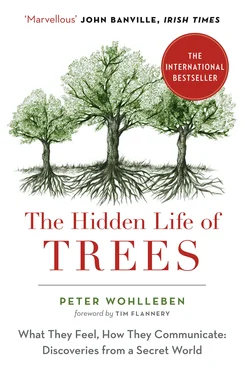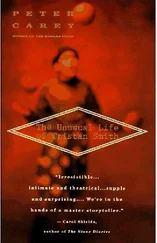When trees grow together, nutrients and water can be optimally divided among them all so that each tree can grow into the best tree it can be. If you “help” individual trees by getting rid of their supposed competition, the remaining trees are bereft. They send messages out to their neighbors in vain, because nothing remains but stumps. Every tree now muddles along on its own, giving rise to great differences in productivity. Some individuals photosynthesize like mad until sugar positively bubbles along their trunk. As a result, they are fit and grow better, but they aren’t particularly long-lived. This is because a tree can be only as strong as the forest that surrounds it. And there are now a lot of losers in the forest. Weaker members, who would once have been supported by the stronger ones, suddenly fall behind. Whether the reason for their decline is their location and lack of nutrients, a passing malaise, or genetic makeup, they now fall prey to insects and fungi.
But isn’t that how evolution works? you ask. The survival of the fittest? Trees would just shake their heads—or rather their crowns. Their well-being depends on their community, and when the supposedly feeble trees disappear, the others lose as well. When that happens, the forest is no longer a single closed unit. Hot sun and swirling winds can now penetrate to the forest floor and disrupt the moist, cool climate. Even strong trees get sick a lot over the course of their lives. When this happens, they depend on their weaker neighbors for support. If they are no longer there, then all it takes is what would once have been a harmless insect attack to seal the fate even of giants.
In former times, I myself instigated an exceptional case of assistance. In my first years as a forester, I had young trees girdled. In this process, a strip of bark 3 feet wide is removed all around the trunk to kill the tree. Basically, this is a method of thinning, where trees are not cut down, but desiccated trunks remain as standing deadwood in the forest. Even though the trees are still standing, they make more room for living trees, because their leafless crowns allow a great deal of light to reach their neighbors. Do you think this method sounds brutal? I think it does, because death comes slowly over a few years and, therefore, in the future, I wouldn’t manage forests this way. I observed how hard the beeches fought and, amazingly enough, how some of them survive to this day.
In the normal course of events, such survival would not be possible, because without bark the tree cannot transport sugar from its leaves to its roots. As the roots starve, they shut down their pumping mechanisms, and because water no longer flows through the trunk up to the crown, the whole tree dries out. However, many of the trees I girdled continued to grow with more or less vigor. I know now that this was only possible with the help of intact neighboring trees. Thanks to the underground network, neighbors took over the disrupted task of provisioning the roots and thus made it possible for their buddies to survive. Some trees even managed to bridge the gap in their bark with new growth, and I’ll admit it: I am always a bit ashamed when I see what I wrought back then. Nevertheless, I have learned from this just how powerful a community of trees can be. “A chain is only as strong as its weakest link.” Trees could have come up with this old craftsperson’s saying. And because they know this intuitively, they do not hesitate to help each other out.
4 4 / Love 5 / The Tree Lottery 6 / Slowly Does It 7 / Forest Etiquette 8 / Tree School 9 / United We Stand, Divided We Fall 10 / The Mysteries of Moving Water 11 / Trees Aging Gracefully 12 / Mighty Oak or Mighty Wimp? 13 / Specialists 14 / Tree or Not Tree? 15 / In the Realm of Darkness 16 / Carbon Dioxide Vacuums 17 / Woody Climate Control 18 / The Forest as Water Pump 19 / Yours or Mine? 20 / Community Housing Projects 21 / Mother Ships of Biodiversity 22 / Hibernation 23 / A Sense of Time 24 / A Question of Character 25 / The Sick Tree 26 / Let There Be Light 27 / Street Kids 28 / Burnout 29 / Destination North! 30 / Tough Customers 31 / Turbulent Times 32 / Immigrants 33 / Healthy Forest Air 34 / Why Is the Forest Green? 35 / Set Free 36 / More Than Just a Commodity Note from a Forest Scientist by Dr. Suzanne Simard Notes Index Acknowledgments About the Publisher
— LOVE — 4 / Love 5 / The Tree Lottery 6 / Slowly Does It 7 / Forest Etiquette 8 / Tree School 9 / United We Stand, Divided We Fall 10 / The Mysteries of Moving Water 11 / Trees Aging Gracefully 12 / Mighty Oak or Mighty Wimp? 13 / Specialists 14 / Tree or Not Tree? 15 / In the Realm of Darkness 16 / Carbon Dioxide Vacuums 17 / Woody Climate Control 18 / The Forest as Water Pump 19 / Yours or Mine? 20 / Community Housing Projects 21 / Mother Ships of Biodiversity 22 / Hibernation 23 / A Sense of Time 24 / A Question of Character 25 / The Sick Tree 26 / Let There Be Light 27 / Street Kids 28 / Burnout 29 / Destination North! 30 / Tough Customers 31 / Turbulent Times 32 / Immigrants 33 / Healthy Forest Air 34 / Why Is the Forest Green? 35 / Set Free 36 / More Than Just a Commodity Note from a Forest Scientist by Dr. Suzanne Simard Notes Index Acknowledgments About the Publisher
THE LEISURELY PACE at which trees live their lives is also apparent when it comes to procreation. Reproduction is planned at least a year in advance. Whether tree love happens every spring depends on the species. Whereas conifers send their seeds out into the world at least once a year, deciduous trees have a completely different strategy. Before they bloom, they agree among themselves. Should they go for it next spring, or would it be better to wait a year or two? Trees in a forest prefer to bloom at the same time so that the genes of many individual trees can be well mixed. Conifers and deciduous trees agree on this, but deciduous trees have one other factor to consider: browsers such as wild boar and deer.
Boar and deer are extremely partial to beechnuts and acorns, both of which help them put on a protective layer of fat for winter. They seek out these nuts because they contain up to 50 percent oil and starch—more than any other food. Often whole areas of forest are picked clean down to the last morsel in the fall so that, come spring, hardly any beech and oak seedlings sprout. And that’s why the trees agree in advance. If they don’t bloom every year, then the herbivores cannot count on them. The next generation is kept in check because over the winter the pregnant animals must endure a long stretch with little food, and many of them will not survive. When the beeches or oaks finally all bloom at the same time and set fruit, then it is not possible for the few herbivores left to demolish everything, so there are always enough undiscovered seeds left over to sprout.
“Mast years” is an old term used to describe years when beeches and oaks set seed. In these years of plenty, wild boar can triple their birth rate because they find enough to eat in the forests over the winter. In earlier times, European peasants used the windfall for the wild boar’s tame relatives, domestic pigs, which they herded into the woods. The idea was that the herds of domestic pigs would gorge on the wild nuts and fatten up nicely before they were slaughtered. The year following a mast year, wild boar numbers usually crash because the beeches and oaks are taking a time-out and the forest floor is bare once again.
When beeches and oaks put blooming on hold for a number of years, this has grave consequences for insects, as well—especially for bees. It’s the same for bees as it is for wild boar: a multi-year hiatus causes their populations to collapse. Or, more accurately, could cause them to collapse, because bees never build up large populations in deciduous forests in the first place. The reason is that true forest trees couldn’t care less about these little helpers. What use are the few pollinators left after barren years when you then unfurl millions upon millions of blossoms over hundreds of square miles? If you are a beech or an oak, you have to come up with a more reliable method of pollination, perhaps even one that doesn’t exact payment. And what could be more natural than using the wind? Wind blows the powdery pollen out of the blossoms and carries it over to neighboring trees. The wind has a further advantage. It still blows when temperatures fall, even when they drop below 53 degrees Fahrenheit, which is when it gets too chilly for bees and they stay home.
Читать дальше












